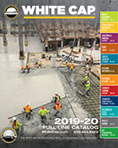OSHA Considers Silica Rule Revisions
OSHA Requests Information to Revise Construction Silica Rule
• On August 14, 2019 The Occupational Safety and Health Administration released a request for information (RFI) on one section of its Silica Standard for Construction. The agency is considering revisions to the rule’s list of construction methods considered safe enough to protect workers from dangerous levels of silica dust.
• The request for information specifically asks for data on the effectiveness of dust collection systems for several tools, including handheld power saws, stationary masonry saws, handheld drills, power sanders, paint scrapers, and water systems for drills
• OSHA is also interested in information on the effectiveness of floor or pedestal fans for blowing dust away from workers and whether demolition work using manual tools could be included in Table 1.
• Construction companies, tool manufacturers, and others looking to comply with rules that aim to protect workers from silica dust would get to share their ideas with regulators.
• The deadline to respond is Oct. 14, 2019.
To read the corrected OSHA Trade Release, click here https://www.osha.gov/news/newsreleases/trade/08142019
Facts Regarding This OSHA request
The rule’s Table 1 details 18 methods contractors can use to limit how much airborne silica dust is produced (29 C.F.R. 1926.1153). Typically, the methods involve vacuuming the silica dust or using water to keep the dust from becoming airborne.
Here’s What We Think:
The long-awaited request for information may address one section of the code that seemed very difficult for contractors to fully comply.
Currently OSHA requires contractors not adhering to Table 1 to have air monitoring programs measuring how much silica dust each worker is exposed to, provide regular medical reviews of workers’ silica exposure, and in some instances provide personal protection equipment such as respirators. The request for information may help convince OSHA rule makers to list additional guidelines to Table 1 eliminating the required testing and reporting for these non-adhering tasks.
One such common task not in Table 1 is mixing mortar. This is a common task performed in thousands of jobsites each day. When industry requested that it be included in Table 1 during the review period of the standard, OSHA officials replied that there are too many variables in the mixing process to include that task in Table 1. Members of the Mason Contractors Association of America have been monitoring exposure assessment on employees performing this task for the last two years. The general results have not found any laborer with results exceeding the Action Level (AL).
It is important to note that the request does not include any change to the current rule that sets a permissible exposure limit (PEL) for airborne crystalline silica of 50 micrograms per cubic meter of air (50 μg/m3). Many opponents to the rule issued in 2016 insist that the 80% reduction from the old construction limit of 250 μg/m3 was too severe and undocumented. Several groups challenged the rule, but the U.S. Court of Appeals for the District of Columbia Circuit upheld it in December 2017.
While the request is a positive move to address practical concerns of the current law, there is no assurance that change will occur. Contractors want an expansion to the rule’s list of approved practices, while unions want to ensure that any changes don’t increase employee exposure risks. One thing is certain, the Silica Rule will not be going away any time soon.
There is some hope that the request for information may yield improvements. At the time the rules were being developed, there was not a great deal of field data demonstrating why many common tasks should be included in Table 1.
The industry has responded to this challenge. For the past 18 months, several national contractor groups such as the Concrete Drilling and Sawing Association and the American Society of Concrete Contractors have been urging their members to collect samples of silica exposure from actual jobsites.
Many of these contractor members have enrolled in the Contractor Employee Association’s Silica Sampling & Objective Data Program. This program makes it possible for contractors to access an affordable silica testing program. But the key benefit is the searchable sampling database for the construction industry. Participating contractors can use the database to manage employee safety and multiple-contractor activities where job tasks produce respirable silica emissions.
Other industry groups such as the American Society of Safety Professionals are asking their technical members to assemble comments for submission as well.
Lastly, one issue for many contractors revolves around defining and training a “competent person”. While the current call for information addresses important concerns in Table 1, some safety professionals are hopeful the RFI will address this common field issue.
Potential Next Steps for Rule Clarification
The current standard does not specify particular training requirements for “competent persons”. Instead, it defines a competent person in terms of capability, i.e., whether a designated competent person has the knowledge and ability to perform the duties prescribed by the standard. The employer must also give the competent person the authority to perform those duties. See 29 C.F.R. § 1926.1153(b).
To determine whether a given employee has the appropriate knowledge and ability to perform the duties of the competent person, an employer needs to confirm that the employee is capable of:
-
Identifying existing and foreseeable silica hazards; and
-
Promptly eliminating or minimizing those hazards.
A person with these capabilities (whether acquired through training, education, work experience, or otherwise), who is authorized by the employer to perform the duties of a competent person, qualifies as a competent person under the standard.
Contractors are reminded to be diligent following this portion of the standard. As with most OSHA standards it is performance-based, allowing field inspectors some ambiguity with interpretations.
![]()
Check out this link for more detailed information about silica news and regulations. https://news.whitecap.com/silica-regulations/
Read OSHA’s Request For Information here:
https://www.federalregister.gov/silica-specified-exposure-control-methods





Table 1 is shot,
Anyone cutting masonry should be designated a respirator and a cut station 25 yds from other personal.